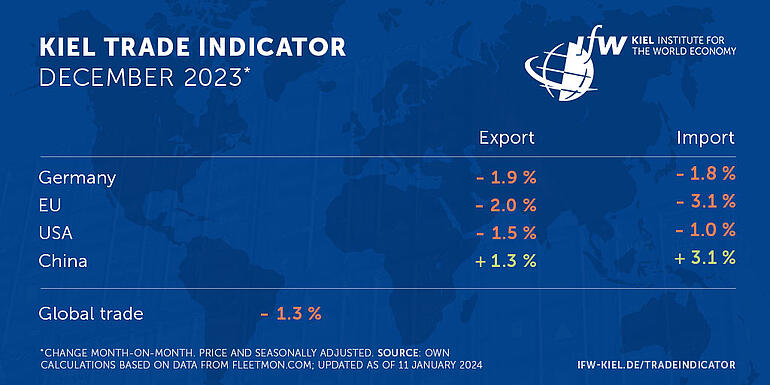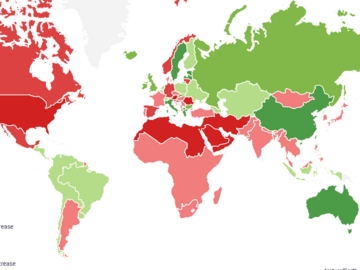News
Cargo volume in the Red Sea collapses

The latest data update of the Kiel Trade Indicator for December 2023 points to a continuation of the slightly negative trend in global trade and trade between major economies. The conflict in the Middle East, in particular attacks on container ships in the Red Sea, is likely to be one reason for the weak trading month.
Global trade fell by 1.3 percent from November to December 2023 (price and seasonally adjusted).
For the EU, the indicator figures for both exports (-2.0 percent) and imports (-3.1 percent) are clearly in the red.
Germany's foreign trade continued the weak phase of recent months, with exports (-2.0 percent) and imports (-1.8 percent) falling again month-on-month.
The Kiel Trade Indicator value for exports (-1.5 percent) and imports (+1.0 percent) shows a decline in December trade in the USA, even though the sea route through the Red Sea and the Suez Canal plays a lesser role there than in Europe.
China's trade is bucking the trend, with figures for both exports (+1.3 percent) and imports (+3.1 percent) pointing upwards. Parts of this increase may be due to an annual peak before the Chinese New Year.
"The detour of ships due to the attacks in the Red Sea around the Cape of Good Hope in Africa means that the time it takes to transport goods between Asian production centers and European consumers is significantly extended by up to 20 days," says Julian Hinz, Director of the Trade Policy Research Center and new head of the Kiel Trade Indicator. "This is also reflected in the declining trade figures for Germany and the EU, as transported goods are now still at sea and have not already been unloaded in the ports as planned.”

The number of containers shipped in the Red Sea fell drastically by more than half in December. The current volume is only around 200,000 containers per day, compared to around 500,000 containers in November. This means that the current volume is 66 percent below the volume actually expected, calculated from the freight volume for the years 2017 to 2019.
Red Sea cargo volumes plummet, but little negative impact on world trade expected
Instead of sailing through the Red Sea, the ships now sail around Africa and the Cape of Good Hope, a detour that takes 7 to 20 days. The longer journey time has significantly increased freight rates, with the transport of a 40-foot standard container between China and Northern Europe currently costing over 4,000 US dollars, compared to around 1,500 US dollars in November. However, the current price is still a far cry from the drastic spikes during the coronavirus pandemic, when transporting a container on this route cost up to 14,000 US dollars.
"Accordingly, despite a noticeable increase in transportation costs, no noticeable consequences for consumer prices in Europe are to be expected, especially as the proportion of freight costs in the value of goods for high-priced items, such as consumer electronics, is only in the per mille range," says Hinz.
"The situation today is not comparable to the environment during the Evergiven accident in the Suez Canal and the coronavirus pandemic, when lockdowns led to a drastic reduction in the supply of goods and demand in Europe exploded at the same time. Apart from slightly longer delivery times for products from the Far East and increased freight costs, to which the container ship network should quickly adjust, no negative consequences for global trade are to be expected."
For more information on the Kiel Trade Indicator and forecasts for 75 countries and regions, visit www.ifw-kiel.de/tradeindicator.
The next update of the Kiel Trade Indicator will take place on February 7 for January trade data.
About the Kiel Trade Indicator
The Kiel Trade Indicator estimates trade flows (imports and exports) of 75 countries and regions worldwide, the EU and world trade as a whole. Specifically, the estimates cover over 50 individual countries as well as regions such as the EU, sub-Saharan Africa, North Africa, the Middle East or emerging Asia. It is based on the evaluation of ship movement data in real time. An algorithm programmed at the Kiel Institute uses artificial intelligence to analyze the data and translates the ship movements into price and seasonally adjusted growth figures compared with the previous month.
We update the data once a month around the 5th and then present the latest calculations for trade in the current and the previous month.
Arriving and departing ships are recorded for 500 ports worldwide. In addition, ship movements in 100 maritime regions are analyzed and the effective utilization of container ships is derived from draught information. Country-port correlations can be used to generate forecasts, even for countries without their own deep-sea ports.
Compared to previous leading trade indicators, the Kiel Trade Indicator is available much earlier, is much more comprehensive, relies on a uniquely large database using big data, and has a low statistical error by comparison. The algorithm of the Kiel Trade Indicator uses machine learning, so that the quality of the forecast continues to improve over time.

